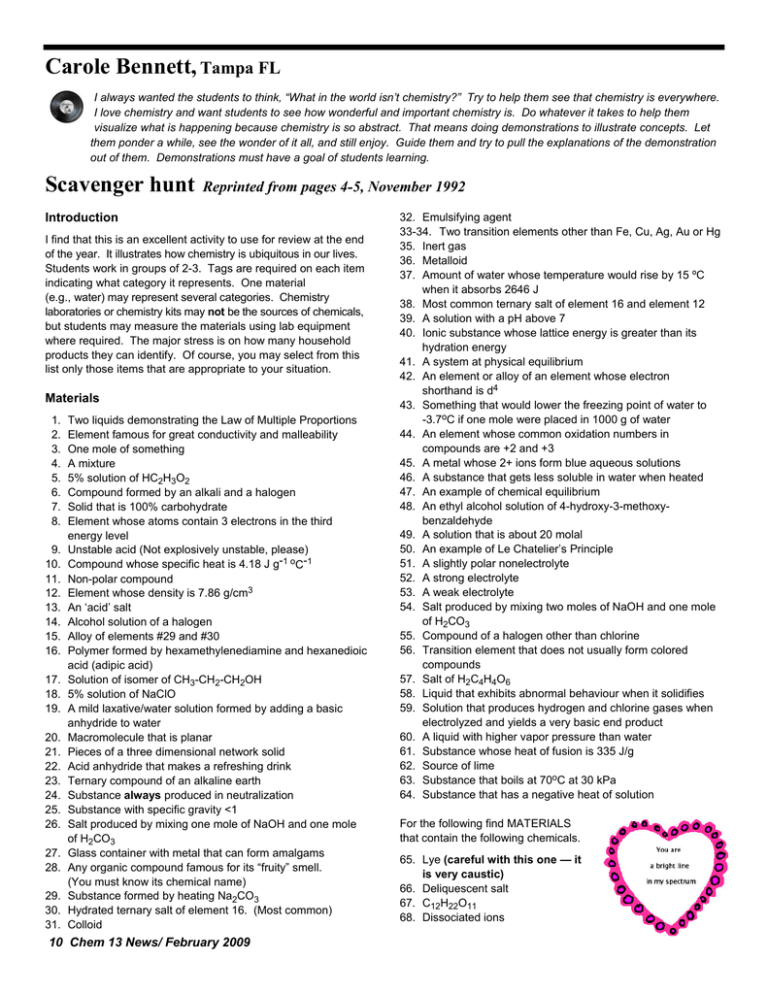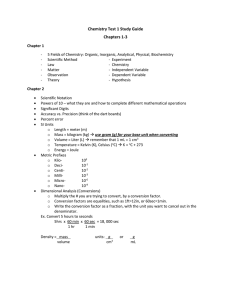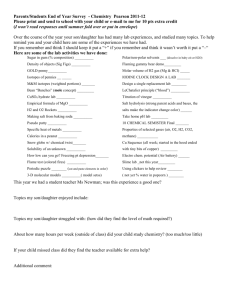Carole Bennett
advertisement

Carole Bennett, Tampa FL I always wanted the students to think, “What in the world isn’t chemistry?” Try to help them see that chemistry is everywhere. I love chemistry and want students to see how wonderful and important chemistry is. Do whatever it takes to help them visualize what is happening because chemistry is so abstract. That means doing demonstrations to illustrate concepts. Let them ponder a while, see the wonder of it all, and still enjoy. Guide them and try to pull the explanations of the demonstration out of them. Demonstrations must have a goal of students learning. Scavenger hunt Reprinted from pages 4-5, November 1992 Introduction I find that this is an excellent activity to use for review at the end of the year. It illustrates how chemistry is ubiquitous in our lives. Students work in groups of 2-3. Tags are required on each item indicating what category it represents. One material (e.g., water) may represent several categories. Chemistry laboratories or chemistry kits may not be the sources of chemicals, but students may measure the materials using lab equipment where required. The major stress is on how many household products they can identify. Of course, you may select from this list only those items that are appropriate to your situation. Materials 1. 2. 3. 4. 5. 6. 7. 8. 9. 10. 11. 12. 13. 14. 15. 16. 17. 18. 19. 20. 21. 22. 23. 24. 25. 26. 27. 28. 29. 30. 31. Two liquids demonstrating the Law of Multiple Proportions Element famous for great conductivity and malleability One mole of something A mixture 5% solution of HC2H3O2 Compound formed by an alkali and a halogen Solid that is 100% carbohydrate Element whose atoms contain 3 electrons in the third energy level Unstable acid (Not explosively unstable, please) Compound whose specific heat is 4.18 J g-1 oC-1 Non-polar compound Element whose density is 7.86 g/cm3 An ‘acid’ salt Alcohol solution of a halogen Alloy of elements #29 and #30 Polymer formed by hexamethylenediamine and hexanedioic acid (adipic acid) Solution of isomer of CH3-CH2-CH2OH 5% solution of NaClO A mild laxative/water solution formed by adding a basic anhydride to water Macromolecule that is planar Pieces of a three dimensional network solid Acid anhydride that makes a refreshing drink Ternary compound of an alkaline earth Substance always produced in neutralization Substance with specific gravity <1 Salt produced by mixing one mole of NaOH and one mole of H2CO3 Glass container with metal that can form amalgams Any organic compound famous for its “fruity” smell. (You must know its chemical name) Substance formed by heating Na2CO3 Hydrated ternary salt of element 16. (Most common) Colloid 10 Chem 13 News/ February 2009 32. Emulsifying agent 33-34. Two transition elements other than Fe, Cu, Ag, Au or Hg 35. Inert gas 36. Metalloid 37. Amount of water whose temperature would rise by 15 ºC when it absorbs 2646 J 38. Most common ternary salt of element 16 and element 12 39. A solution with a pH above 7 40. Ionic substance whose lattice energy is greater than its hydration energy 41. A system at physical equilibrium 42. An element or alloy of an element whose electron shorthand is d4 43. Something that would lower the freezing point of water to -3.7oC if one mole were placed in 1000 g of water 44. An element whose common oxidation numbers in compounds are +2 and +3 45. A metal whose 2+ ions form blue aqueous solutions 46. A substance that gets less soluble in water when heated 47. An example of chemical equilibrium 48. An ethyl alcohol solution of 4-hydroxy-3-methoxybenzaldehyde 49. A solution that is about 20 molal 50. An example of Le Chatelier’s Principle 51. A slightly polar nonelectrolyte 52. A strong electrolyte 53. A weak electrolyte 54. Salt produced by mixing two moles of NaOH and one mole of H2CO3 55. Compound of a halogen other than chlorine 56. Transition element that does not usually form colored compounds 57. Salt of H2C4H4O6 58. Liquid that exhibits abnormal behaviour when it solidifies 59. Solution that produces hydrogen and chlorine gases when electrolyzed and yields a very basic end product 60. A liquid with higher vapor pressure than water 61. Substance whose heat of fusion is 335 J/g 62. Source of lime 63. Substance that boils at 70oC at 30 kPa 64. Substance that has a negative heat of solution For the following find MATERIALS that contain the following chemicals. 65. Lye (careful with this one — it is very caustic) 66. Deliquescent salt 67. C12H22O11 68. Dissociated ions 69. 70. 71. 72. Small amounts of hydrosulfuric acid from Florida aquifer Starch, acid salt and sodium hydrogen carbonate Base indicator used as a laxative Liquid known for its high viscosity due to H bonds (not water) 73. CH3 C CH3 41. O 74. 75. 42. O H H C O O H H O H H H C O CH3 76. Any ionic fluoride 77. Two substances produced when Ca(OH)2 and NH4Cl are heated 78. Tannic acid Answers 1. 2. 3. 4. 5. 6. 7. 8. 9. 10. 11. 12. 13. 14. 15. 16. 17. 18. 19. 20. 21. 22. 23. 36. 37. 38. 39. 40. Water and hydrogen peroxide Any metal Usually 18 mL of water Salt water, salt and pepper, etc. Vinegar Salt is most common possibility Sugar, fructose, starch, etc. Aluminum Carbonic acid in sodas Water Oil, kerosene, gasoline, cooking oil, etc. Iron NaHCO3 Tincture of iodine Brass Nylon Rubbing alcohol is isopropyl alcohol Chlorine bleach, ‘Chlorox’ Mg(OH)2 is in Milk of Magnesia Graphite in pencil ‘leads’ Sand or quartz CO2 makes acid in sodas Epsom salts, MgSO4; gypsum in wall board, CaSO4, or chalk, CaCO3 24. Water 25. Cork, plastic, cooking oil, etc. 26. Baking soda, NaHCO3 27. Mercury fever thermometer 28. Ester such as ethyl acetate in fingernail polish, or amyl acetate in banana flavoring 29. Carbon dioxide 30. Epsom salts, MgSO4•7H2O 31. Jell-O, whipping cream, etc. 32. Soap, detergent, egg yolks (lecithin) 33-34. Nickel 5 cent piece, chrome auto part, Ti earrings, sunglasses coated with iridium, and tungsten light filament are the most common examples 35. I planned on Ne, Ar or Kr in old ‘neon’ signs, but got He balloons 43. 44. 45. 46. 47. 48. 49. 50. 51. 52. 53. 54. 55. 56. 57. 58. 59. 60. 61. 62. 63. 64. 65. 66. 67. 68. 69. 70. 71. 72. 73. 74. 75. 76. 77. 78. Si or Ge from computer or calculator chip 42.2 mL water Epsom salts, magnesium sulfate Milk of Magnesia, lime water, bleach, etc. Most ionic salts, e.g., NaCl. One brought ammonium nitrate from a ‘cold pack’ Sealed container with liquid, e.g., the contents of a soda can are in vapor-liquid equilibrium Tungsten filament from light bulb — you decide whether to accept a chrome plated auto part (Cr is 3d54s1) NaCl is easiest choice. Any ionic salt with one cation and one anion Iron Copper Any gas, e.g., CO2 or NH3 from aqueous household ammonia H2CO3 ⇌ H2O + CO2 in a sealed soda can Vanilla flavoring ‘Fudge’ is about 20 m when first cooked. (My students make fudge to show colligative properties) Soda can when first opened; relieve stress on gas and the equilibrium shifts to right Any alcohol, e.g., isopropyl; sucrose NaCl is easiest Vinegar Washing soda, Na2CO3 Film has AgBr and Agl. Toothpaste has fluoride. Some scrubbing powders have bromides for bleaching. Zinc nails or ‘galvanized’ iron ‘Cream of tartar’ is KHC4H4O6 Water expands as it freezes Solution of NaCl produces H2 at cathode, Cl2 at anode and NaOH remains Alcohol, gasoline, fingernail polish remover, etc. Water Limestone, chalk, marble, CaCO3 Water Lye, NaOH; battery acid, H2SO4 is also possible ‘Red Devil’ brand lye is almost pure NaOH CaCl2 used in closet dehumidifiers Sucrose (table sugar) Salt water or solution of any ionic salt ‘Sulfur’ water has H2 dissolved in it Baking powder Phenolphthalein is ingredient in ‘Ex-Lax’ Honey, syrup, etc. are easiest. Glycerin or ethylene glycol would also work but are less common in a home Acetone as solvent for glues, some cheap fingernail polish removers Phenol is in acne preparations like ‘Clear-a-Sil’ Aspirin, acetylsalicylic acid Some toothpastes contain SnF2 or NaF Ammonia and water in household ammonia Tea Reference The original idea for this activity was published in an issue of Chem 13 News in the 1970s. I have lost the reference and author’s name. I have greatly expanded the material. ∎ February 2009/Chem 13 News 11




